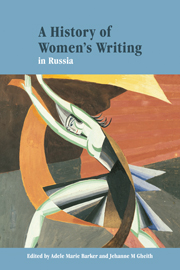Book contents
- Frontmatter
- Contents
- Notes on contributors
- Acknowledgments
- Note on transliteration
- List of abbreviations
- Introduction
- 1 Women's image in Russian medieval literature
- 2 Sappho, Corinna, and Niobe: genres and personae in Russian women's writing, 1760–1820
- 3 The inexperienced muse: Russian women and poetry in the first half of the nineteenth century
- 4 Women of the 1830s and 1850s: alternative periodizations
- 5 “A particle of our soul”: prerevolutionary autobiography by Russian women writers
- 6 The women of Russian Montparnasse (Paris, 1920–1940)
- 7 Women in Russian Symbolism: beyond the algebra of love
- 8 The eastern path of exile: Russian women's writing in China
- 9 Realist prose writers, 1881–1929
- 10 Women and gender in post-symbolist poetry and the Stalin era
- 11 Writing the female body politic (1945–1985)
- 12 In their own words? Soviet women writers and the search for self
- 13 Women's poetry since the sixties
- 14 The persistence of memory: women's prose since the sixties
- 15 Perestroika and post-soviet prose: from dazzle to dispersal
- Bibliographical guide to writers and their works
- Guide to further reading
- Index
2 - Sappho, Corinna, and Niobe: genres and personae in Russian women's writing, 1760–1820
Published online by Cambridge University Press: 22 September 2009
- Frontmatter
- Contents
- Notes on contributors
- Acknowledgments
- Note on transliteration
- List of abbreviations
- Introduction
- 1 Women's image in Russian medieval literature
- 2 Sappho, Corinna, and Niobe: genres and personae in Russian women's writing, 1760–1820
- 3 The inexperienced muse: Russian women and poetry in the first half of the nineteenth century
- 4 Women of the 1830s and 1850s: alternative periodizations
- 5 “A particle of our soul”: prerevolutionary autobiography by Russian women writers
- 6 The women of Russian Montparnasse (Paris, 1920–1940)
- 7 Women in Russian Symbolism: beyond the algebra of love
- 8 The eastern path of exile: Russian women's writing in China
- 9 Realist prose writers, 1881–1929
- 10 Women and gender in post-symbolist poetry and the Stalin era
- 11 Writing the female body politic (1945–1985)
- 12 In their own words? Soviet women writers and the search for self
- 13 Women's poetry since the sixties
- 14 The persistence of memory: women's prose since the sixties
- 15 Perestroika and post-soviet prose: from dazzle to dispersal
- Bibliographical guide to writers and their works
- Guide to further reading
- Index
Summary
Introduction: the cultural background
The westernization of Russian culture that began in earnest during the reign of Aleksei Mikhailovich (1645—1676) affected women's writing slowly. Up to the middle of the eighteenth century, the only genre of writing to which women made any significant contributions was the private letter (as had been the case in pre-Petrine times too). Most letters, as in previous generations, remained routine and ungrammatical communications of mundane content. Only in the late eighteenth century did the letter turn into something resembling an art form. The letters of Catherine II, or of Masha Protasova, niece and protégée of the poet Vasilii Zhukovskii, are just as “literary”, if not — in the second case, at least — as playful, as the more famous missives of the “Pushkin pleiad” two decades later.
But private correspondence, if still the main genre to which women contributed (in terms of numbers involved), was, from the 1750s, no longer the only, or indeed the most important, vehicle for their work. It was at this date that women began, at first hesitantly, to become involved in the creation of literatura, the new tradition of imaginative writing that had been implanted in Russia about a century earlier. One important factor that prompted their participation was the increased social and political prominence of women in the post-Petrine period.
- Type
- Chapter
- Information
- A History of Women's Writing in Russia , pp. 37 - 61Publisher: Cambridge University PressPrint publication year: 2002
- 1
- Cited by



